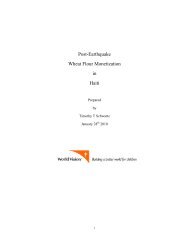Right to Livelihoods in Haiti
Focus on egg production and rural household livelihood strategies
Focus on egg production and rural household livelihood strategies
Create successful ePaper yourself
Turn your PDF publications into a flip-book with our unique Google optimized e-Paper software.
10<br />
Table 2: Comparison of Prices <strong>in</strong> <strong>Haiti</strong> Before and After June 6 th 2012 Ban on Imported Eggs<br />
Before<br />
After<br />
Car<strong>to</strong>n S<strong>in</strong>gle S<strong>in</strong>gle<br />
Car<strong>to</strong>n S<strong>in</strong>gle S<strong>in</strong>gle<br />
of 30 Raw Boiled Raw Boiled of 30 Raw Boiled Raw<br />
import import import local local import import import local<br />
eggs Egg egg egg egg eggs Egg egg egg<br />
Boiled<br />
local<br />
egg<br />
LOCATION<br />
Ouanam<strong>in</strong>th 100 5 5 8 n/a 125-50 5 5 10 n/a<br />
Cape <strong>Haiti</strong>an 135 5 7 8 10 175 8 10 10 15<br />
Port Margot 135 5 7 7 10 200 8 10 10 15<br />
Port-de-Paix 175 7 10 8 15 250 9 10 10 15<br />
Gonaive 125 5 8 8 10 225 9 10 10 15<br />
Gros Morne 125 5 8 8 10 225 9 10 10 15<br />
Jean Rabel 150 5 8 8 10 250-75 10 10 10 15<br />
Mare Rouge 150 5 n/a n/a n/a 250 10 n/a 10 n/a<br />
Bombardopolis 150 5 n/a n/a n/a 300 10 n/a 10 n/a<br />
Port-au-Pr<strong>in</strong>ce 125 5 7.5 10 15 200 10 10 10 20<br />
Jeremie 175 7 10 8 12 230 10 10 10 15<br />
Dame-marie 200 7 8 8 10 300 10 10 10 15<br />
Les Cayes 150 6 8 7 10 200 10 10 10 15<br />
Jacmel 125 5 8 8 10 200 10 10 15 20<br />
Mirabalais 125 5 5 8 10 225 10 10 10 15<br />
As disparag<strong>in</strong>g as the prospects for egg production may be, Dom<strong>in</strong>ican imports have their problems <strong>to</strong>o.<br />
They must get the eggs <strong>to</strong> the border. The eggs must cross the border and be transported throughout<br />
<strong>Haiti</strong>, typically <strong>in</strong> dilapidated vehicles without refrigeration and across rough roads. This means broken<br />
eggs, lost time, and spoilage. Hav<strong>in</strong>g said that, producers <strong>in</strong> Les Cayes region are gett<strong>in</strong>g close <strong>to</strong> be<strong>in</strong>g<br />
competitive, sometimes sell<strong>in</strong>g eggs for 5.5-6.0 Htg per egg versus the price at the border <strong>in</strong> Ouanam<strong>in</strong>the<br />
of 5 Htg. Yet, the 10-13% difference is still enough for major entrepreneurs <strong>in</strong> the South <strong>to</strong> travel <strong>to</strong> the<br />
farthest po<strong>in</strong>t <strong>in</strong> <strong>Haiti</strong> from Les Cayes—Ouanam<strong>in</strong>th—buy illegal eggs, and then transport them all the<br />
back <strong>to</strong> Les Cayes, risk<strong>in</strong>g spoilage, broken eggs, and hav<strong>in</strong>g <strong>to</strong> pay bribes at two <strong>in</strong>spection stations.<br />
The Prospect for Small Scale Egg Production <strong>in</strong> <strong>Haiti</strong><br />
Despite unfavorable tariffs, a lack of government subsidies and technical programs, and a paucity of feed<br />
process<strong>in</strong>g facilities there is a very real opportunity for <strong>in</strong>creased egg production <strong>in</strong> <strong>Haiti</strong>. There is an<br />
enormous demand for eggs throughout <strong>Haiti</strong>. Even if Dom<strong>in</strong>ican imports were <strong>to</strong> be frozen at the current<br />
level, producers can expect market growth. <strong>Haiti</strong>ans annually consume only 45 eggs per person—<br />
compared <strong>to</strong> 258 per person <strong>in</strong> the USA and 200 <strong>in</strong> the Dom<strong>in</strong>ican Republic, the latter figure up from 124<br />
ten years ago. The <strong>Haiti</strong>an government, hav<strong>in</strong>g restricted Dom<strong>in</strong>ican importation, has a mechanism <strong>to</strong><br />
<strong>in</strong>crease and restrict the importation of eggs at will, artificially rais<strong>in</strong>g and lower<strong>in</strong>g prices of imported<br />
eggs when needed and giv<strong>in</strong>g an advantage <strong>to</strong> local producers. Eggs produced throughout the country<br />
would be closer <strong>to</strong> markets, mean<strong>in</strong>g less spoilage and fewer broken eggs, another advantage <strong>to</strong> domestic<br />
production. Moreover, eggs have an advantage over production of chickens for meat <strong>in</strong> that they can be<br />
s<strong>to</strong>red more easily, at no cost <strong>in</strong> feed, and they are far more marketable <strong>in</strong> rural areas. There may also be<br />
alternative means <strong>to</strong> promote egg production <strong>in</strong> <strong>Haiti</strong>, one more <strong>in</strong> l<strong>in</strong>e with the semi-subsistence farm<strong>in</strong>g
















